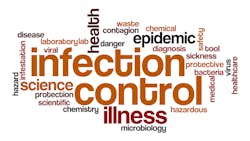Questions and answers about infection control for dental practices in light of COVID-19
Editor's note: This article is a special COVID-19 edition of Dr. Gordon Christensen's monthly column, Ask Dr. Christensen. It provides authoritative guidance on infection control products, which have been independently tested for effectiveness.
This month's question
This month, the major question is coming from me—Dr. Gordon Christensen! The person answering it is another Dr. Christensen—Rella Christensen, PhD, microbiologist, physiologist, and director of the TRAC component of Clinicians Report Foundation.
We recently presented an online course titled, Preparing to return to practice in the new COVID-19 world, in which Rella addressed many of the infection control concerns being expressed by dental professionals. Those interested in seeing the entire three-hour presentation can find it at pccdental.com.
Rella, of the hundreds of questions submitted before, during, and following the course, what are the ones most frequently asked at this time, and how would you answer them?
Answer from Dr. Rella Christensen
The ability of the SARS CoV-2 virus to pass from healthy-appearing carriers and cause significant illness or death in random unsuspecting individuals has forced all segments of dentistry to reconsider infection control practices and products. It has been known for many decades that aerosols are created routinely by dental procedures that use rotary instruments of any kind, lasers, ultrasonic scalers, air-driven abrasive polishers, and even hand instruments. The continuous flow of various secretions and pulverization of highly colonized hard and soft tissues during treatment are so second nature to dental clinicians that few have stopped to consider the dangers. Because most of the particles and all of the microbes are invisible—and because incubation periods make it difficult to link infection to an exact moment in time—it has been easy over the years to become casual about the aerosol problem in dental offices.
Although ambient air indoors and outdoors is loaded with all kinds of invisible floating debris, and a healthy immune system allows most humans to overcome incredible challenges, when one randomly comes in contact with an antigen (virus or bacteria) that is new to one’s immune system, things can go downhill quickly. Listed below are six of the most frequent questions we receive at Clinicians Report Foundation. Some of the answers have come from extensive microbiological research using actual clinical environments and laboratory research.
No. 1: What should we do about dental aerosols?
There is a confusing array of air treatment methods and products becoming available for use in dental offices. Dental clinicians need to decide up front how serious they are about this issue, because the products being offered range from highly efficacious to ridiculous, with costs and installation convenience covering the same wide spectrum. Currently, we commonly see four basic approaches to aerosol control.
Physical clearance—This method involves (a) intake of contaminated air, (b) treatment to purify that air, and (c) release of the treated air within the operatory or outside the operatory. The most prevalent current product designs differ mainly in where and how the contaminated air is gathered. Extraoral suction devices have an extending arm with a collection “hood” attached to the end. This hood is positioned near the patient’s oral cavity and designed to suction debris released during treatment extraorally; then a HEPA filter filters it, and the purified air is released back into the operatory. HEPA filtration consoles come in various sizes that treat the air in the same way but may lack the arm and draw in the air more remotely. A less prevalent variation on the HEPA filtration console design lacks the console and uses HEPA filters built into the ceiling over the treatment space, releasing purified air over the operating clinicians.
Chemical treatment—This method involves the release of aerosolized chemicals that disinfect the air in the operatory by killing free microbes and those attached to dust, liquids, small hairs, etc. The plasmas or fogging chemicals generally used are highly oxidative and decompose potentially into harmless substances such as oxygen and water.
Ultraviolet light treatment—This method involves light energy at specific wavelengths (265 nm is considered optimum, but 254 nm is most common) that can disrupt nucleic acids of microbes within aerosols to inactivate them, if the organisms are susceptible and exposed long enough to the energy.
Various combinations of these approaches can be used within the same device.
All four approaches have advantages, disadvantages, and can mitigate potential threats, but none of these approaches used alone will solve all problems. We have now found two systems that exhibit high promise, but even these will need to be coupled with efficacious personal protective equipment (PPE), surface disinfection that kills in the presence of oral secretions, and carefully designed air flow.
There are two products we have noted as exceptional. Both systems can also be engineered to convert a dental operatory into a negative-air operating space, if desired.
• ECM Phantom [Gordon Cleanroom Products, (888) 315-1561]—uses overhead HEPA filtration and bathes the local operating area above the dentist, patient’s oral cavity, and attending dental assistant with super-clean air.
• Safe-T-Shield [Ergonomic Products, (800) 275-2547]—provides high-quality vision through a plastic shield that places a transparent barrier between the heads of the clinician and patient. The shield is attached to a suction arm that pulls the aerosols under the shield and through an arm into HEPA filtration, and then releases purified air into the operatory or outdoors.
No. 2: What is the best face mask, and can we sterilize and reuse them?
There is a face mask called Critical Care PFL with Magic Arch (Alpha ProTech) with a unique design that gives it the following three characteristics necessary for protection: (a) a soft wire all the way around its border allows the clinician to adapt a secure fit to all facial contours, over the nose and cheeks and under the chin; (b) two stiff bands cause the mask to protrude enough to hold it away from contacting the mucus membrane of the nostrils and lips at all times, including during talking and inhalation; and (c) very high filtration of greater than 99% of 0.1 µm particles. This face mask was shown in our testing to have the best combination of protective features compared to other level 3 face masks. An N95 face mask with a very similar design called the Isolator Plus (Crosstex) is also available. This N95 mask has the advantage of being more comfortable than many other designs.
Face mask sterilization is theoretically possible, and, in periods of high shortages, it offers what could be the only alternative to wearing no mask. However, several problems can arise. First, you would like to be assured the mask was rendered sterile by the process and not distorted to the point that its secure-fitting border was compromised. Second, you would like to think it was still filtering properly. The material the mask is made from is meant to actually entrap incoming and outgoing debris in the form of droplets, aerosols, dust particles, and free-floating bacteria or viruses. Like your furnace filter, face mask material becomes impregnated with whatever is in the air and at some point "fills up"—at which point it begins to allow material to pass through and loses its filtration capability. While you are hoping to kill the infectious viruses or bacteria through some type of sterilization, the sterilization process itself does not clear the face mask material of particles that have become entrapped within it, and at some point, it can lose its filtration capability. Unfortunately, you have no way to know the point at which this happens.
No. 3: What is the best way to disinfect surfaces?
The answer to this question depends on what surfaces you have in mind—for example, in-operatory or sterilization counters, walls, and cabinets; equipment such as patient and operator chairs, radiograph units, computers, and over-the-patient screens; front desk and reception areas; and floors and window blinds.
Operatories and sterilization areas—Counters, cabinets, and walls in these areas are contaminated routinely with oral aerosols, spatter, and smears composed of all types of oral contents, including small particles of hard and soft tissue, blood, saliva, crevicular fluid, and sometimes suppuration or pus. For many years, we have urged the disinfectant industry to provide robust disinfectants that would kill broad spectrum and quickly in the presence of such contaminants. This would allow clinicians to clean and kill simultaneously without exposing themselves to the viable microbes present immediately after patient treatments. Disinfectant brands capable of this have come and gone on the market, but all have been high ethyl alcohol (> 70% by volume) formulations. Currently, our research has identified BioSURF Bag-in-a-Box (Micrylium) as having the best combination of the robust excellent kill described above, a dispensing design that preserves kill potential of the chemicals until actual use, availability of a companion noninterfering wipe material called LeCloth (Micrylium), and biodegradability of all components. However, if used after each patient, this disinfectant may degrade finishes on the equipment in your office.
Equipment—Often, equipment is best managed by covering it with barriers. But since most equipment does not touch critical tissues, less potent disinfectants could be used as a conscious second-best choice.
Front desk and reception areas—BioSURF Bag-in-a-Box and barriers would be appropriate for some of the most touched surfaces in these areas, as well as in office bathrooms. We have suggested that patient reception areas be used as minimally as possible, by receiving patients before they enter the office and giving them some kind of disposable hand covering before bringing them into a fully prepared operatory.
Floors and window blinds—Hard-surface floors and either no window treatments or blinds that can be disinfected are noncritical, but contaminated surfaces. Detergents with household bleach or other reasonable additives could be used here. Floors should be wet-disinfected nightly. Rugs and fabrics are definitely problematic in today’s health-care facilities.
No. 4: Should we put on a fresh clinical gown for each patient, and what about hygiene checks?
The answer is yes. It is possible to don a fresh gown for each patient and hygiene check if you secure disposable gowns that will tolerate steam sterilization and wear them over a shirt and washable pants. Although sterilization eventually affects disposable gowns negatively, some will tolerate several runs through the sterilization cycle. The biggest problem is the size of your steam sterilizer chamber. The gowns can be folded or rolled loosely for the sterilization process. A rotation system needs to be developed to assure that enough fresh gowns are always available. For hygiene checks, simply remove the gown used for ongoing treatment and leave it in the operatory to await your return and put on a fresh disposable gown as you enter the hygiene operatory. Leave that gown in the hygiene operatory so it can be sterilized along with other items that are used for the hygiene procedure.
Is it necessary now to have a fresh gown for each patient? This has not become an established policy, but doing so provides the best prevention of patient-to-patient cross contamination. Established policy states that, after use, clinical attire can be washed or sterilized in the office, professionally laundered, or disposed of—but it is not to be worn out of the office and/or laundered at home.
No. 5: What are the steps and products for the best hand disinfection?
This is an area where we and others have good research data using humans as test subjects. First, several points must be understood:
• Hands carry both transient and resident organisms. The transients are fortunately easier to address, and they are the ones you pick up during contact with surfaces/objects of all types.
• Cuticles and areas under the fingernails and jewelry both serve as places where microbes are sheltered and retained, and they can be carried and transferred for days.
• Hand skin is almost always compromised somewhere by small cuts or abrasions, allowing microbes to have portals of entry into your body.
These are the steps that result in the most thorough handwashing disinfection (not a surgical scrub):
A. Massage vigorously and thoroughly, covering all hand surfaces plus wrists with a good-quality 4% chlorhexidine hand antiseptic (Hibiclens, Mölnlycke) for 30 seconds, and then rinse under very warm running water to remove visible debris, oils, and transient microbes.
B. Use a new, clean paper towel to dry your hands thoroughly.
C. Dispense a 70% ethyl alcohol hand rub gel (Purell Advanced, GoJo) in sufficient quantity to cover all surfaces of both hands liberally so they remain moist during 30 seconds of massaging the hands together. (A pea-sized dab of gel rubbed between the palms of the two hands for a few seconds will not result in the level of hand disinfection that is necessary.)
Hand rubs can also be used alone without the handwashing steps in A and B above if there is no visible debris apparent. For best disinfection after removing gloves between patients, perform all three steps listed above since microbe buildup occurs when hands remain gloved long enough to become warm and coated with perspiration for many minutes.
No. 6: Is there a product and regimen we can use as a pretreatment rinse?
There is no published human research establishing any one chemical or regimen as best for use as a dental pretreatment rinse when the primary target is viruses. Chlorhexidine rinses in various concentrations are frequently reported in the literature for bacterial reduction, but chlorhexidine is notably less effective for inactivation of the virus. Great confusion has been generated by the COVID-19 crisis with multiple empirical suggestions for use of undocumented antiseptic rinses and regimens that most often include 1.0%–1.5% hydrogen peroxide or 0.2% povidone iodine swished for one minute. Gargling plus rinsing is suggested for at-home use but rinsing alone for dental use to avoid aerosols and spatter. Our work using chlorhexidine for pretreatment rinsing showed the best microbe reduction using two consecutive 30-second rinses, which allowed the first rinse to complex with and tie up much of the mucin and debris in the saliva, leaving the soft and hard tissues more available for direct contact with the antiseptic during the immediate second rinse. However, it should be understood that no clinical studies have been published that validate any of this information about rinses.
Companies and products cited
Air purification:
• Gordon Cleanroom Products (888) 315-1561; ECM Phantom ceiling HEPA filters releasing very pure air over the operating site
• Ergonomic Products (800) 275-2547; Safe-T-Shield ceiling suction under transparent shield between patient’s oral cavity and clinicians
Face masks:
• Alpha ProTech (800) 749-1363; Critical Care PFL with Magic Arch level 3 face mask
• Crosstex (888) 276-7783; Isolator Plus N95 face mask
Surface disinfection:
• Micrylium Laboratories (800) 489-8868; BioSURF Bag-in-a-Box and LeCloth Wipes
Hand disinfection:
• Mölnlycke (800) 882-4582; Hibiclens
• GoJo (800) 321-9647; Purell Advanced
Author’s note: The following educational materials from Practical Clinical Courses offer further resources on this topic for you and your staff.
New three-hour digital course featuring Rella Christensen, PhD:
• Preparing for Your Return to Dental Practice in the New COVID-19 World (Item V2407)
Two-day hands-on courses:
• Infection Control for Every Practice (Item V2452)
• Infection Control Techniques, Step-by-Step (Item V2479)—This is a classic video showing in detail the essential steps in aseptic technique for adequate infection control.
For more information about these educational products, call (800) 223-6569 or visit pccdental.com.
About the Author

Rella P. Christensen, PhD, RDH
Rella P. Christensen, PhD, RDH, has a doctorate in physiology with an emphasis on microbiology from Brigham Young University. She cofounded Clinical Research Associates in 1976 and was its director for 27 years. She is the team leader of Technologies in Restoratives and Caries Research (TRAC Research), a nonprofit institute dedicated to in-depth, long-term clinical studies of restorative materials, preventive dentistry, and dental caries. She practiced dental hygiene for 25 years and founded the University of Colorado’s dental hygiene program.

Gordon J. Christensen, DDS, PhD, MSD
Gordon J. Christensen, DDS, PhD, MSD, is founder and CEO of Practical Clinical Courses and cofounder of Clinicians Report. His wife, Rella Christensen, PhD, is the cofounder. PCC is an international dental continuing education organization founded in 1981. Dr. Christensen is a practicing prosthodontist in Provo, Utah.


